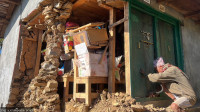Opinion
Zero accident
Proper planning is just as important as safe infrastructure and stringent rules in reducing road mishaps
Ashish Gajurel
About 70 percent of deaths from road accidents occur in developing countries. Sixty-five percent of these deaths involve pedestrians, 35 percent of which are children. Over 10 million are crippled or injured each year. According to a World Bank report, the majority of road crash victims—injuries and fatalities—in countries like ours are not motorised vehicle occupants, but pedestrians, motorcyclists, bicyclists, and non-motorised vehicle occupants. Data from Nepal’s traffic police shows that, on average, five-seven people are killed in road accidents every day.
Road infrastructure
In the past month alone, several serious accidents occurred in Nepal. During the 15 days of the Dashain festival, 138 people died and another 244 were seriously injured in road accidents, including those in Doti and Sindhuli. Twenty-nine people were killed and dozens injured in the Doti bus mishap alone. Similar numbers of deaths were recorded in January 2013 because of a road accident in the same area. Recently, vehicular collisions at Babarmahal in the Capital and in Bharatpur killed three and four people, respectively. These statistics force us to contemplate why road accidents are so frequent in Nepal and how such accidents can be averted. Answers need to be explored and strategies developed and implemented immediately to save lives on the roads.
In Nepal, poor road infrastructure and reckless driving are the leading causes of accidents. The Babarmahal stretch is an eight-lane road that was recently renovated and is in a good condition. In comparison, roads in Doti are rough and poor. This difference, however, does not conclude that accidents are directly proportional to the quality of streets. The Tinkune-Suryabinayak section, of which the Babarmahal stretch is a part, is considered to be the best road segment in Nepal, but it is also one of the most dangerous.
Road users—including drivers, pedestrians and passengers—vehicles, the road
environment, and road infrastructure are the four primary contributors to road crashes and collisions. In our context, the role of poorly constructed roads is often neglected and the blame is usually placed on drivers. This traditional concept needs to be challenged with a proper investigation into each accident. The road and its infrastructure influence a driver’s behaviour as well. A driver’s driving skill is directly related to the street they drive on. Road constructions, therefore, need to comply with all the safety standards prescribed by civil engineering.
A high-risk occupation
Most accidents have causes; they do not simply happen. Roads in Nepal are narrow, with many cracks and potholes. Drivers want to avoid such disturbances. If and when they swerve their vehicles to bypass the interruptions, such actions dramatically increase the likelihood of accidents. Similarly, some drivers, especially of long-distance buses and trucks, drive for more than eight hours daily. Although this is against the labour law of Nepal, law enforcers turn a blind eye to such violations.
Driving a vehicle is a high-risk occupation. Therefore, in developed countries like Germany, France and Belgium, bus drivers work eight hours a day and 40 hours a week. During the working day, breaks are provided in between two consecutive rounds of driving for food, drinks, relaxation, and socialising. Studies attribute 16-19 percent of total road accidents to fatigue and sleepiness. Fatigue might also be the reason behind the Babarmahal accident. The driver could have wanted to reach his destination as soon as possible and relax. This could have led to over speeding that caused the accident. But nothing will be certain until a proper investigation is conducted.
The poor condition of vehicles can also engender road accidents. It is imperative that vehicles are checked thoroughly at times to ensure that they are in proper working conditions. In addition, the drivers’ eyesight should be tested periodically and use of glasses enforced, if required. Driving under the influence is another major cause of road accidents in Nepal. Licences should be cancelled for repeated violations.
Prioritise safety
Another major cause of road accident is vehicles’ exceeding their load capacity. In the recent Doti bus accident, the bus was carrying around 100 passengers—three times the capacity of the bus. If passengers are found travelling on the roofs of vehicles, both drivers and the passengers on top should be punished.
Also, driving tests should be made more stringent and foolproof. Drivers need to be tested on the roads. Although this is the norm in most developed countries, we are a ways from enforcing this here. Traffic education campaigns need to be organised regularly, as well, and the media—television, newspapers, radio, the internet—and other relevant institutions should also conduct programmes in traffic safety to make roads safer for all stakeholders.
Planning has played the biggest part in reducing the road accidents in developed countries. Roads in Sweden are built with safety prioritised over speed or convenience. Low urban speed-limits, pedestrian zones, and barriers that separate cars from bikes and oncoming traffic have helped. Nepal needs to adapt similar strategies and implement policies in an integrated approach. Piecemeal efforts to enhance road safety will never solve
the problem.
Gajurel is a traffic engineer and can be reached at [email protected]




 8.12°C Kathmandu
8.12°C Kathmandu










